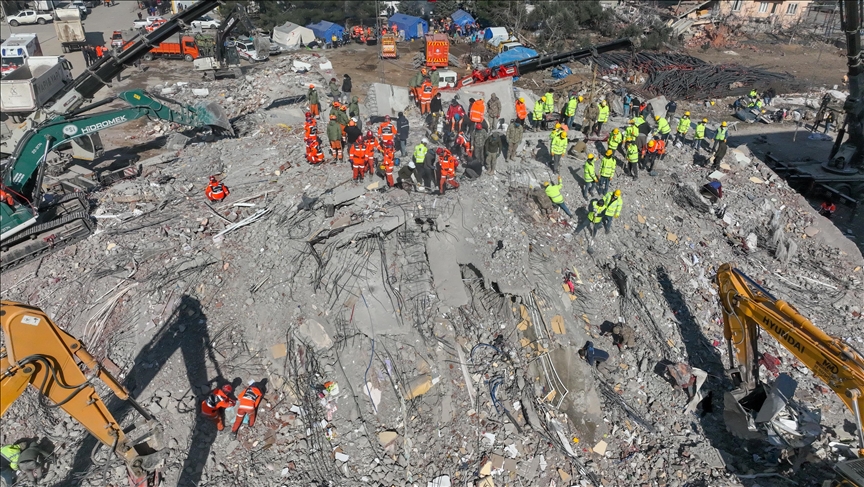ANKARA
Having covered three earthquake disasters in the past 30 years as a reporter, I found the Feb. 6 quakes in Türkiye unprecedented in terms of their impact on a vast area.
I covered the 1993 Latur earthquake in the western Indian state of Maharashtra, the 2001 Bhuj earthquake in nearby Gujarat and the 2005 Kashmir earthquake.
While there were more fatalities in all three of the above quakes, they were limited to smaller areas within a 100-kilometer (62-mile) radius. The Feb. 6 quakes have affected 10 southern and southeastern provinces – namely Kahramanmaras, Hatay, Osmaniye, Gaziantep, Sanliurfa, Diyarbakir, Malatya, Killis, Adana, and Adiyaman in Türkiye and five in Syria – Latika, Idlib, Aleppo, Raqqah, and Al-Hasakah.
In Türkiye alone, it shook an area of nearly 100,000 square kilometers (38,600 square miles) and affected over 13 million people. The distance between Adana and other affected locations in Diyarbakir is about 600 kilometers, so the scale of relief and containment operations is gigantic and requires a large number of trained workers.
On Oct. 8, 2005, the Kashmir earthquake severely affected the area between Uri in Indian-administered Kashmir and Balakot in Pakistan’s Khyber Pakhtunkhwa province, killing 86,000 people. Geographically, however, only a distance of 100 km (62 mi) was affected.
In the Latur earthquake, which killed 10,000 people, the shaking was confined to the Latur and Osmanabad districts in Maharashtra. Similarly, the Bhuj earthquake in 2001, which killed 20,000 on the Indian side and 18 on the Pakistani side, affected the Bhuj and Kutch districts and was limited to a distance of 85 km (53 mi).
In October 2005, when the earth shook in Kashmir, I reached the region the next day from the Indian capital, New Delhi. Since cell phones had just been introduced in the region and were limited only to the capital, Srinagar, there was no communication from the affected area in North Kashmir.
The journey from the Srinagar airport to my hometown of Sopore in North Kashmir, which was partially affected, was difficult as the roads had collapsed in many places. I was given a lift by truck and walked on foot a large distance amid a series of aftershocks until I reached my hometown and saw big cracks on my house. Many old houses in the town were on the ground. But there were no deaths.
Because of constant aftershocks, residents lived on the streets and in the courtyards of their houses, braving cold October nights for several days.
Most affected region
The most affected region was the adjacent administrative block of Uri, directly along the Line of Control (LoC) dividing Jammu and Kashmir into areas controlled by India and Pakistan. Severe destruction occurred in the region. About 90% of the families living in Uri, a city of 30,000 people, were affected by the quake.
The epicenter of the 7.6 magnitude quake was in Muzaffarabad, the capital of Pakistani-administered Kashmir, or Azad Jammu and Kashmir, just 40 km (25 mi) on the other side of the LoC.
According to the Earthquake Disaster Risk Index Report 2019, around 1,500 deaths and 4,50,000 collapsed buildings were reported in Indian-administered Kashmir as a result of the 2005 earthquake.
One positive effect of the disaster was that less than one year afterward, South Asian rivals India and Pakistan agreed to open five border crossings along the heavily militarized frontier line to humanitarian aid and began a peace process that lasted until 2008. It has been shown that natural disasters often provide an opportune time to increase the likelihood of rapprochement.
Joakim Kreutz, a Swedish expert in peace and conflict studies, analyzed 405 different disasters in 21 countries and found that in many regions, talks began and cease-fires were established after disasters.
When the Latur earthquake occurred, the needle of the seismographs at the National Geophysical Research Institute (NGRI) in Hyderabad swang beyond the width of a paper roll, although it had a magnitude of 6 on the Richter scale, less than what Türkiye experienced on Feb. 6.
The 1993 quake also stunned scientists, as the Deccan Plateau in southern India was considered to have little susceptibility to earthquakes.
Early warning
Unlike other disasters, it is important to remember that the unpredictability of earthquakes makes accurate prediction difficult, even with the most advanced scientific instruments. Earthquakes can occur without warning and have significant effects on communities and infrastructure.
Although the Turkish Disaster and Emergency Management Authority (AFAD) has set up an early warning system that gives residents seconds to take cover before an earthquake strikes, the current quake occurred at 4:17 a.m. local time (0117GMT), making it difficult for people to react.
According to Turkish Interior Minister Suleyman Soylu, the country is located in a region that offers great opportunities, but also risks. The country is located in a region that is frequently exposed to natural disasters due to its geological, meteorological and topographical conditions, including earthquakes, landslides, floods, rockfalls, and avalanches.
In recent years, Türkiye has taken several measures to minimize death and destruction during earthquakes, such as building codes, retrofitting existing buildings, emergency planning, and public education. But rescue and reconstruction efforts to mitigate the disaster that affected large parts of Türkiye and Syria require the support of many stakeholders and, most importantly, a skilled workforce to remove the rubble.

